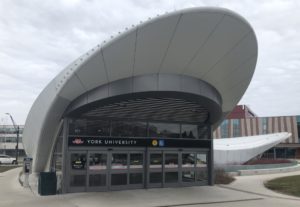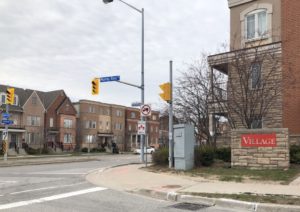York University is well known for being a largely commuter-based campus. Between the two of us, for example, we can count the amount of people we know who live on campus on one hand. Most of our peers come from the Greater Toronto Area and beyond: Mississauga, Richmond Hill, Scarborough, Oakville and even Ajax. Though our treks to campus are quite long in time and distance, we are quite content with making these trips to school every day. To us, commuting is a central part of our identity as York University students. Though it may not be as convenient or glamorous as living in student housing (and living away from parents), it certainly is, for financial reasons, the best option for many students attending York. But how well are we served as commuters? In the last couple of years, and in spite of a subway extension, it turns out that we are not served very well at all. In this short piece we will explain why, and what we as commuters could do about it.
Prior to 2018, most students reached the campus by bus. In 2005, approximately 1600 buses serviced York University’s Keele campus, making it the second most serviced bus hub in the Greater Toronto Area after Pearson International Airport. This all changed with the big fanfare opening of the York University Subway Expansion in late 2017. The University and the media described the opening as a long-awaited and unqualified win for commuters to the campus. There was certainly some truth to that statement with regards to commuters traveling from downtown Toronto. But the subway expansion meant something quite different for those of us coming from outside the city! On one fateful day in November 2017, the York University administration sent us an email explaining that ALL buses which up to that point had serviced the campus –GO Transit, YRT (York Region Transit), and TTC (Toronto Transit Commission)- would be rerouted to the new Pioneer Village and Highway 407 subway stations. For us, still travelling by bus, it necessitated a change from bus to subway in what had previously been a continuous bus trip. But worse, it also meant that, starting in January 2018, we had to pay a second fare to reach the campus by subway, in addition to our regular bus fee which would not be reduced. To soften the blow, the University announced a one-way half-price discount on our TTC fare, but despite the discount we still paid an extra $4.70 in total each day. We were angry. We resisted the decision to reroute the buses and we started an (unfortunately) unsuccessful petition to bring the buses back to campus.
And what seems criminal in light of all of this is that on March 31, 2020, even the subsidized fare expired. Prior to the change we protested again but with no effect, so we now face the financial strain to shell out even more money for the same service.

York University Subway Station: Satisfaction
for some, disappointment for others.
Personally, I (Alana), a self-proclaimed suburbs girl, was very upset (to say the least) with the decision to reroute the buses and charge a double fare. While I figured it wouldn’t be too difficult to learn how to use the subway, I wasn’t happy about adding another mode of transportation to my daily commute. I come to York from Mississauga each day, and before the change I usually got a ride to the nearest GO Bus station where I took an express bus to school. I really enjoyed the convenience of having the buses drop me off practically right at the door of the building where I had my classes. It was especially helpful when the weather was wonky or when I was late for class. Today, things are very different. I now have to walk a longer distance to class and prepare myself for the weather, like bringing an umbrella or warm clothes. But where the bus rerouting has really hit me is in my wallet. Prior to the fare change on January 1, 2018, I paid $36.30 to get to and from school three days a week. Since then, until March 30, 2020, I paid $50.40 with the additional subway fare. Now I currently pay $55.50, though I can count myself lucky because I am graduating at the end of the Winter term. As a student who is only able to work once or twice a week, this increase has had quite the impact on me financially. This school year, I opted to put all my classes on the same three days each week and to take more online classes, limiting the amount of days I would have to pay for transit to get to school. This has restricted my opportunities to be involved in on-campus activities.

The York University Commons was teaming with a continuous flow of buses in the past, carrying students to the campus from all kinds of places in the Greater Golden Horseshoe, including the campus of McMaster University. The Commons is now, as seen in this photo, almost devoid of any traffic.
My (Natalie) experience differed in that my life was more intimately tied to campus. I moved into student housing even prior to the subway extension. Being a varsity athlete, I had practices and games to attend in addition to my classes. When the subway arrived in 2017, I flirted with the idea of moving back to my home in Scarborough. All the transit links I would be using fell under the TTC, so my long ride would only be one fare. However, by this time, not only did I have a spread-out class schedule to accommodate my varsity commitments, but I had secured a job on campus as well. It just made more sense to remain where I was (at this time, the Quad student residence at York) and use the subway when I would visit family and friends back home. My initial reasoning for picking a Toronto based school for my undergrad was that I would be able to remain at home. However, life got in the way of those plans and because the transit services were not supportive of rapid transit from the East end to campus, I resorted to relocating.
So how do we move forward? Having both been impacted by the subway extension (and from hearing the impacts from many others), we decided to explore what a more equitable transit solution might look like. One step towards transit equity relates to transparency. At first, we felt, echoing the sentiments of many other students, that bringing back the GO buses to campus was the way to go, so that users could avoid a change in transit mode and wouldn’t be hit with a double fare anymore. However, through our research and discussions with stakeholders in the extension project –in particular Professor Ted Spence who retired from the project in 2007– we were convinced that the removal of the GO buses from the Harry W. Arthur Commons made sense, because it alleviated the traffic congestion on Jane and Keele north of Steeles. Indeed, this is something we had both personally experienced, often getting caught in grueling 35 minute-gridlocks after leaving the York campus during rush hour. There was just one problem: The rerouting was always a part of the subway extension plan, but the planners forgot to tell us about it. What is the lesson for transit planners? Be transparent about your plans and be sure to explain the reasons for them!
Fare integration is the second response to the achievement of transit equity. This takes shape when different transit service providers cooperate to make fare prices reflective of the distance users travel irrespective of how many transit boundaries they cross. Currently, those outside of the Toronto region are disproportionately charged for the same service as Toronto residents. This unfair pricing creates barriers between commuters and their access to York University as well as the city of Toronto. The sad part of this, as Professor Spence told us, is that fare integration was an integral part of the project at the outset , but it somehow slipped through the cracks as development moved forward. What is the lesson for transit planners? Be insistent that fare integration is solidly entrenched in any plans! If it so easily slipped through the cracks during the multi-billion-dollar York University expansion project, it could certainly be left out again.
Thinking about where transit equity planning generally and at York University specifically can go from here is quite the complex question. Our recommendation is to make all transit free (as it already is in a few countries around the world). We know that is not something that would occur overnight, but it is something that would meet equity as well as environmental objectives. We also found that the selection of transit mode is an important consideration, where, for example, a Light Rapid Transit system can be more economical and serve more people than subways. We also learnt that conventional house subdivisions, such as built on campus in the last two decades, may not be the best choice to serve and be served by public transit.

The Village at York, a new urbanist but still low-density and car-based housing subdivision built on the York University campus around 2005-2010. Is this type of housing arrangement the most appropriate for public transit?

High density housing build recently at the Wilson Subway Station. Is this a public transit-compatible housing development?
Being divided on transit issues creates more barriers to securing more equitable transit for everyone. Since our eyes were opened to the larger political arrangements at play within transit planning, we wrote this piece to shed light on some of these issues. At York University, we urge students, staff and faculty to become more engaged in transit equity issues, and, as a good beginning, make sure that the concept of fare integration becomes situated as the key priority in transit planning.
References
Collens, M., Hertel, S., Keil, R. (2015). Switching Tracks. Retrieved from https://suburbs.info.yorku.ca/files/2015/03/Switching-Tracks_9-March-2015.pdf
Collens, M., Hertel, S., Keil, R. (2016). NEXT STOP: EQUITY - Routes to fairer transit access in the Greater Toronto and Hamilton Area. Toronto, ON. Retrieved from: https://city-apps01-yorku-ca.ezpoxy.library.yorku.ca//wp-content/uploads/2016/02/Transit-Equity_Reduced_020216.pdf
Spence, Ted. (2013). THE SPADINA SUBWAY EXTENSION THROUGH YORK UNIVERSITY - REFLECTIONS ON THE STRUGGLE FOR APPROVALS. Contour Lines. York Geography Alumni Association.
Subsidy for discounted GO Transit, TTC fares to be discontinued by Ford government | CBC News. (2019, July 9). Retrieved from https://www.cbc.ca/news/canada/toronto/government-stop-funding-subsidy-discounted-toronto-transit-fares-1.5205707
Alana Barone is a fourth year environmental studies student specializing in environmental politics. Next year she plans on attending Humber College to receive a graduate diploma in television writing and producing.
Natalie Maw is a fourth year environmental studies student specializing in environmental politics and a former varsity athlete. She plans to pursue a masters degree in environmental media and communications.



